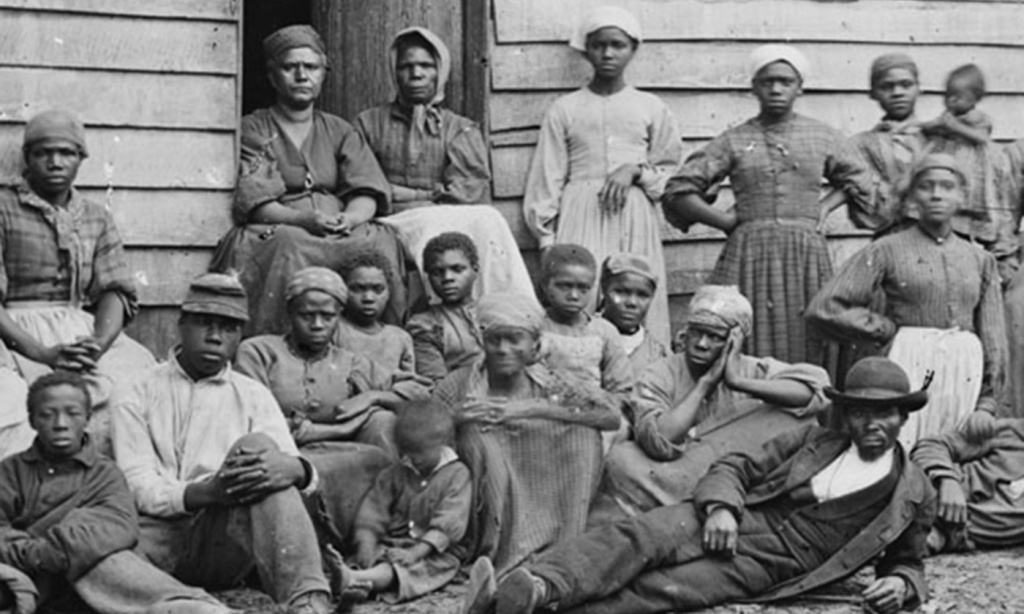
Each Sunday I try to index at least one batch of records on FamilySearch.org. Last Sunday, I chose to index Prince William County, Virginia, birth records and ended up with a batch from 1857. The batch presented as a ledger with one record per line; on this page there were 43 lines, so 43 babies recorded. Each line had a space for the child’s color, and an indication whether the child was born free or slave, in addition to the expected male or female. There was also a space for the father’s name, but the instructions made clear that some fathers’ names were owners’ names for children born into slavery, and the indexing form had places for both father’s names and owner’s names. Father’s place of residence (all Prince William County) and mother’s name were also listed. The ledger was all in the same handwriting and the dates were not in order, which made me think it was probably a transcript of original records submitted to the county.
A pattern soon became apparent. Sometimes the name of the child was listed as “no name,” but all white, male children had names. The children who were listed as slaves had only first names, no last names. If a child was white, a W was placed in the box for the child’s color. If a child was not white, the color box was left blank. If a child was white, the free or slave boxes were left blank (after all, no white child would be born a slave in that era; they were all free). If the color box was blank, then the free or slave box would be filled in, depending on the child’s status. If the child was a slave, the “father” listed was actually the child’s owner (and possible biological father, given that enslaved women were sometimes raped to produce more “property” for their enslavers). The fathers’ occupations were almost all farmers, with a couple of coopers (barrel-makers) and a merchant. Free, nonwhite children’s fathers’ names were listed. For white children and nonwhite free children, the mother’s full married name was listed; for enslaved children, only the mother’s first name was listed. The relationship of the informant was, for white and nonwhite free children, listed as father; for enslaved children, the relationship was owner.

There were three free, nonwhite families listed; twenty white families; twenty-three enslaved children with their owners and mothers (hardly to be considered families). I have tried to imagine what life must have been like in Prince William County in 1857. The Civil War search engine at Dickinson College in Carlisle, Pennsylvania, “House Divided,” reports about 1857:
After a contentious presidential election during the previous year, many Americans hoped that 1857 would finally bring political calm. They were sorely disappointed. Two days after James Buchanan (Class of 1809) was inaugurated president, Chief Justice Roger Taney (Class of 1795) announced the Supreme Court’s controversial verdict in the Dred Scott Case. The result was more outrage and greater division over slavery. But by the year’s end, bad economic news trumped the political storm as nearly five thousand businesses failed during what became known as the Panic of 1857.
“The Year in Review: 1857,” House Divided: The Civil War Research Engine at Dickinson College, http://hd.housedivided.dickinson.edu/almanac/1857
Prince William County, with a border on the Potomac River and encompassing locales that later became the Northern Virginia metro area of Washington D.C., had been an area of tobacco plantations before the Revolutionary War, but exhaustion of the soil and changes in the market led planters to cultivate other crops after about 1790. In that year, the population of the county was 58% white, with the remainder being enslaved Black people; a few enslavers freed their slaves after the American Revolution (Wikipedia, s.v., “Prince William County, Virginia,” https://en.wikipedia.org/wiki/Prince_William_County,_Virginia). Ronald Ray Turner’s website on Prince William County, in the African American Records section, lists court, contract, and deed records concerning free and (mostly) enslaved African Americans from 1784–1859, with 1857 transcripts involving rewards for runaway slaves, the rental of unnamed slaves who were part of the estate of a man who had died, and many letters and other proceedings concerning the conviction and death penalty pronounced upon five slaves who killed their master in 1856.
I assume that at the time the children listed in the 1857 record were born, the county was roiling from the brutal murder of George E. Green by his slaves Nelly, James, and Newman, who were hanged, and 14-year-old twins Elias and Eliza, whose sentences were later commuted to sale and transportation “beyond the boundaries of the United States.” (The adults testified that Green was “a hard master,” starved them, would not let them leave his property or do other things that other people’s “servants” were allowed to do, and made them work during the Christmas holidays, contrary to tradition.) (“Virginia Governors Executive Papers—Henry Wise; Commonwealth v. Nelly and Others”; “Prince William County Clerk’s Loose Papers, December 16, 1856,” obtained through Ronald Ray Turner, “Prince William County: African American Records,” http://www.pwcvabooks.com/RonsRamblings.htm)
Based on that assumption, I expect that there was a crackdown on the Black population of the county that year by the white population, with a lot of fear among white people because five slaves had dared to kill their master the previous Christmastime. Both free and enslaved Black people probably had to tiptoe on eggshells even more than usual, lest their white enslavers and the other white people of the county see them as threats, with possibly dire or even fatal consequences to a Black man, woman, or child considered “uppity.” The entire country was undoubtedly aware of slave revolts taking place from 1712 to that present day; runaway slaves were being hunted; the Kansas–Nebraska Act of 1854 made all politically conscious minds aware of the debate in white society over whether new states were going to be free or slave; John Brown’s raid on Harper’s Ferry was only two years in the future (Ibram X. Kendi, Stamped from the Beginning: The Definitive History of Racist Ideas in America [New York: Bold Type Books, 2016], 69–208; 202–203; 207–208). The Civil War would begin in about five years, in 1861.
It was, perhaps, no time or place to be bringing a Black child into the world. If they survived early childhood, both white and Black children’s circumstances were probably affected by the economic Panic of 1857. They would be only eight years old when the Civil War ended in 1865, having seen the First and Second Battles of Bull Run (Manassas) take place in their county, along with other, lesser-known battles and skirmishes. The county hosted Confederate soldiers and was occupied by Union soldiers during the war; 25 places are listed on the county’s “Civil War Heritage Trail” (Prince William County, “Visit Prince William County,” n.d., https://www.visitpwc.com/history/civil-war-trail/).

And yet, by the time the Civil War ended, those Black children born in 1857 would have been declared free. They would live through the hopeful era of Reconstruction, only to see any progress made eroded by the institution of Jim Crow laws and the terrorism of the Ku Klux Klan and other white supremacists. (See generally, Ta-Nehisi Coates, We Were Eight Years in Power: An American Tragedy [New York: One World, 2017]; Henry Louis Gates Jr., Stony the Road: Reconstruction, White Supremacy, and the Rise of Jim Crow [New York: Penguin Books, 2020].) Between the end of the Civil War and the end of World War II, when those children would be 88 years old, they would see their country undergo years of segregation and discrimination against Black people, and perhaps have a glimmer of hope that things might change—although that hope would rise and then be dashed again and again.

As I thought of those 43 children who were defined from the beginning of their lives by their color, I realized that they now had the privilege of being indexed so their records will be available to people searching out their family histories. I have no illusions that African American genealogical research, especially for descendants of enslaved people, is easy. That enslaved children and their mothers were given no last names, and no biological fathers were recorded, means that connections are almost impossible to make without additional records that are almost always nonexistent. The Prince William County courthouse burned in 1863 (like so many Southern courthouses during the Civil War), and that makes research for the descendants of this “class of 1857” even more difficult.
Those children’s lives surely had the happiness and sadness that we all experience, but their birth in the turmoil of the mid-nineteenth century seems the first step on what, for many of them, must have been a hard road. I picture them as precious, cute, chubby babies, each a beloved child of God, their earthly parents proud or perhaps unhappy to welcome them into what must have seemed a world embroiled in trouble and uncertainty—with more to come. Some of my ancestors owned slaves and fought for the Confederacy in the Civil War, and I am ashamed of that aspect of my heritage. I have been reading a lot for the past three years about the history of African Americans in the United States and of racism in the world. I am trying to be an anti-racist and wish there were something more I could do to advance the cause of anti-racism and see that Black people are given the help and opportunities they need and deserve. I plan to learn more about African American genealogical research and I hope to choose indexing batches where I can record more of those precious lives; lives that deserve to be recorded and cherished in memory by their descendants and by us all.

